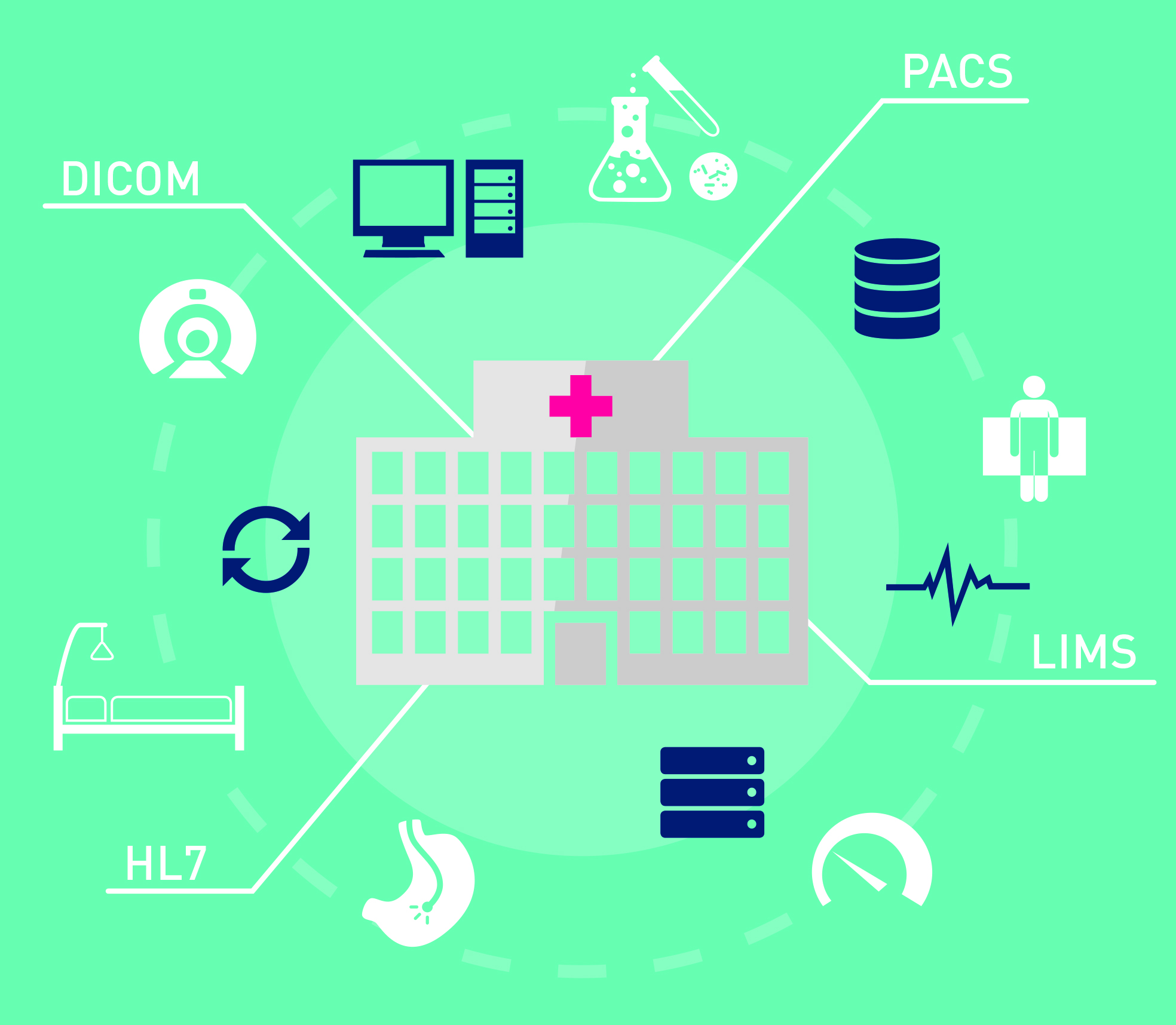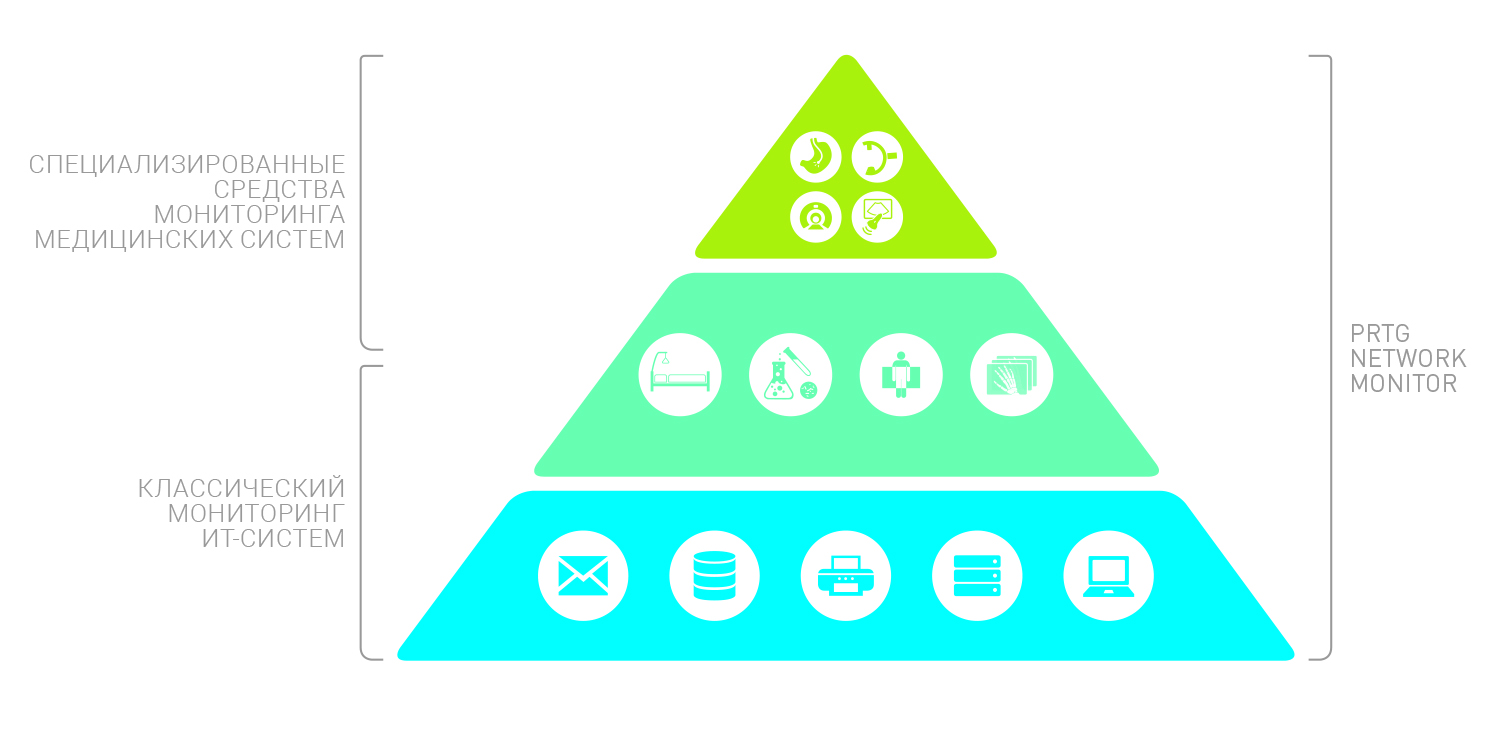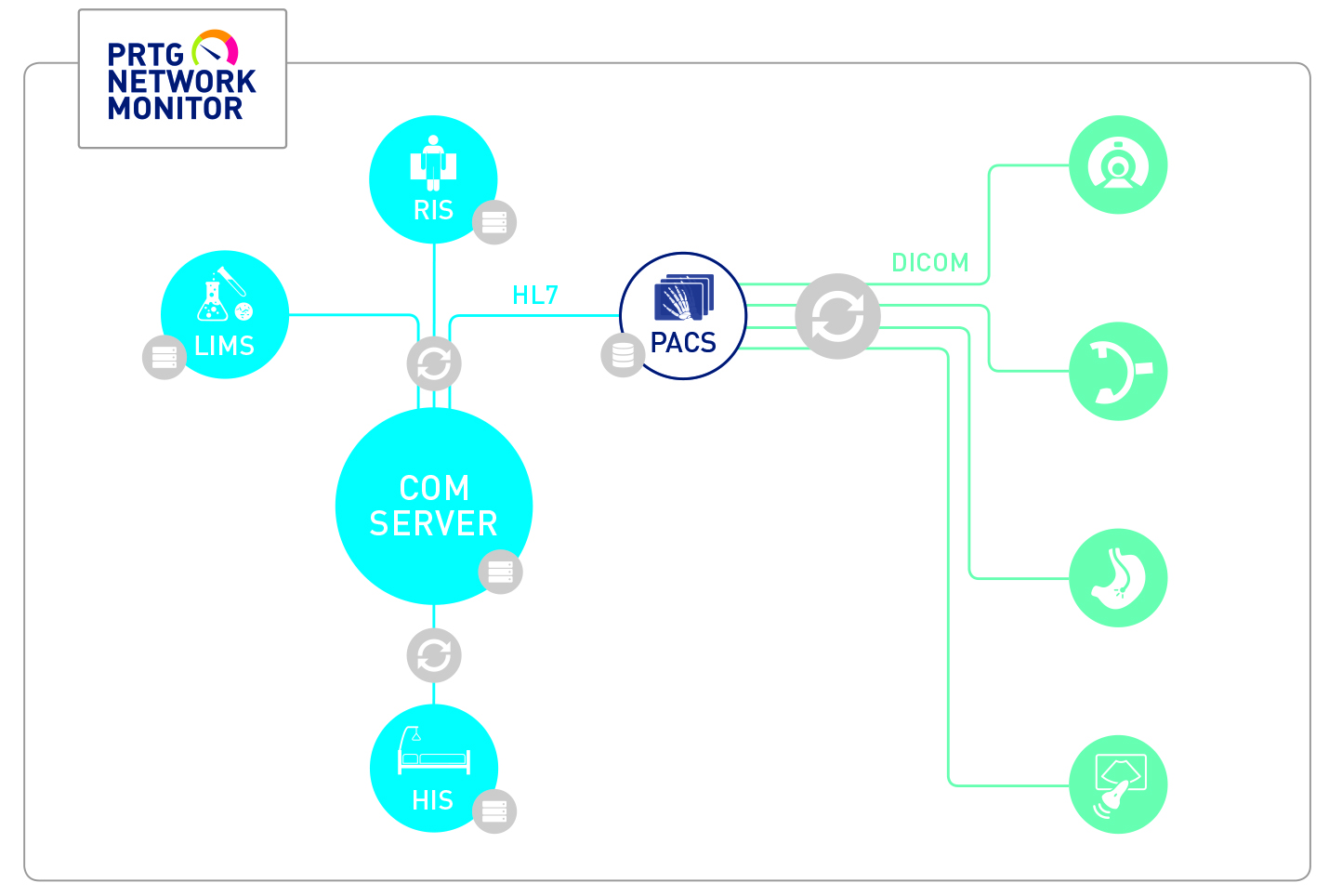Monitoring of IT infrastructure in medicine
 |
The degree of informatization of modern hospitals is very high. The availability of patient data is a key factor that determines the quality of it infrastructure. It is crucial that doctors have the opportunity to access patient data on demand, and that they always receive it without difficulty, the coordinated work of various IT systems is needed. These systems include medical and imaging devices, medical imaging system data, information systems, and a centralized communication server, as well as traditional IT infrastructure such as switches, servers, databases, and storage. |
Digital Transformation and Centralization
 |
Pyramid of Monitoring Solutions for Modern Healthcare Facilities
Digital transformation in modern hospitals began several years ago. As a result of this process, responsibility for the medical infrastructure is shifted to the IT department. Why? |
Some of the reasons become apparent when you look at how doctors work today. Digital screens are replacing printouts: 15 years ago, patients were shown printouts of X-rays, while now images are sent directly to wall monitors or to a doctor’s tablet. In most cases, doctors need quick access to patient data:
radiographs, MRI and ultrasound results, laboratory tests or the results of examination by a specialist, medical histories or information about the main attending physician of the patient.
All this data is transmitted through the following HOSPITAL IT systems:
• HIS (Hospital Information System) – basic and reference data
• LIMS (Laboratory Information System) – laboratory test data
• RIS (Radiological Information System) – radiological data
Images of radiographs, the results of MRI and ultrasound studies, as well as videoendoscopy are stored in the PACS system (Image Archiving and Transmission System). Most hospitals now have a central communication server that connects these systems together, so that the doctor will have access to all the necessary information about patients at any time.
IT as the foundation of a communication system
All medical systems require a classic IT infrastructure for data exchange, which is responsible for data transmission and includes network equipment. This requires cables, routers, servers, and storage systems, as well as Wi-Fi networks and related access points. Security also plays a very important role. Enterprise IT systems are no longer isolated; they are closely related to the systems of various organizations (insurance companies, others) clinics, administrative institutions, information systems of buildings). Because of this, the requirements for firewalls, antivirus scanners, and intrusion detection systems become extremely high.
Monitoring tools in the hospital
The goal of classic IT systems is to guarantee the necessary level of performance and security. At this basic level, which medical devices and systems rely on, comprehensive monitoring of IT systems is required. Device availability, data rate requirements, and application performance require continuous monitoring. In the network itself monitoring or IT monitoring is nothing new – many similar solutions are available. However, many of them do not have the ability to integrate medical devices with monitoring systems.
Some companies use self-written solutions, but they tend to require a lot of development effort and have limited functionality. Professional monitoring systems have a large number of functions for analyzing, storing, collecting and publishing data, as well as Mechanisms for notifying users of failures.
Creating a self-written monitoring solution is becoming an overwhelming task for most hospital IT departments, and the functionality of such a solution leaves much to be desired. There is a risk that two separate systems will be created and responsibility for them will be blurred. All this, in turn, negatively affects the overall transparency of the corporate infrastructure. Let’s go back to our stories about the rentenogram. Let’s say a doctor is waiting for a patient. What should he do if the X-ray doesn’t come to his tablet? He’ll likely ask the medical equipment department if the X-ray machine is working. If he is fine, then the doctor should then check the PACS and RIS systems, as well as the communication server. If all medical devices work properly, then most likely the error relates to the operation of conventional IT equipment: maybe the switch or firewall does not work or a data transfer error occurs. The more systems and responsible persons, the more difficult it is to find a point of failure. And the benefits of a centralized system that monitors both standard IT equipment and medical systems are enormous.
PRTG – a solution for both medical and IT equipment
PRTG Network Monitor is developed by Paessler. The roots of this company lie in the field of classical IT technologies: its solutions are used by 200 thousand companies around the world and set the standard in the field of network monitoring. Paessler has expanded the capabilities of the Custom REST sensor and the DICOM and HL7 protocols to make centralized monitoring in the healthcare sector even easier.
 |
PrTG’s solution integrates IT and medical infrastructure and ensures their joint monitoring.
PRTG’s Custom REST sensors provide connectivity to communications servers such as Soffico’s Orchestra using the RESTful API. The DICOM protocol provides the ability to monitor images from X-ray machines, MRI devices, ultrasound and videoendoscopy. HL7 is the most common protocol for transmitting patient data, and thanks to the native PRTG functions, data from systems such as HIS, RIS and LIMS can be displayed in a centralized monitoring window. |
The transfer, storage, analysis and publication of data in medical systems occurs in the same way as in conventional IT networks. PRTG users can set thresholds above which they will receive a warning. In this way, it will be possible to prevent a failure before the onset. They decide how to receive such alerts: via e-mail, SMS, push notification or other means.
The notification function is very useful for monitoring specialists: they will immediately establish the source of the problem and understand whether measures have been taken by responsible persons.
PRTG provides a single picture of two worlds: classical IT and medical IT. With Drag & Drop, users will be able to create personalized dashboards to visualize all the technological components needed for a medical facility. The dashboard can display outages, interference, or malfunctions as they occur. It can be configured to inform responsible specialists about problems or send them alarms.
Many hospitals have several branches. Free PRTG remote probes are an easy and cost-effective way to monitor different sites with just one instance (license) of PRTG. Another flexible feature of PRTG is rest Custom Sensor. With it, the administrator can easily integrate all devices with the REST API into the PRTG system. In this way, refrigerators, sensors can be connected to monitor temperature, air quality or humidity, as well as systems to ensure safety in the local environment.
Synopsis
Next, we list the features that make PRTG an ideal monitoring solution in hospitals:
• PRTG features built-in support for DICOM and HL7 device monitoring
• Overview of the status of RIS, KIS, LIMS, PACS and all IT equipment in your hospital
• Integration of all communication servers
• Single solution for medical and IT systems
• One license is enough for monitoring in multiple branches
• Custom sensor REST sensor to integrate monitoring of other devices
Access to personal data is not carried out
The HL7 protocol is used to manage and transmit patient data. PRTG uses it in order to guarantee secure data transmission and monitor the necessary devices. PRTG does not have access to personal data.
Only the data types, the amount of data transferred, the status of communication channels and devices are monitored.